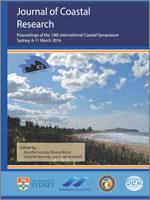Buckley, E.C.B.; Hilton, M.J., Konlechner, T.M., and Lord, J.M., 2016. Downwind sedimentation and habitat development following Ammophila arenaria removal and dune erosion, Mason Bay, New Zealand. In: Vila-Concejo, A.; Bruce, E.; Kennedy, D.M., and McCarroll, R.J. (eds.), Proceedings of the 14th International Coastal Symposium (Sydney, Australia). Journal of Coastal Research, Special Issue, No. 75, pp. 268–272. Coconut Creek (Florida), ISSN 0749-0208.
Since 2002 Ammophila arenaria has been progressively eradicated from a section of the transgressive dune system at Mason Bay, New Zealand to restore dune mobility. This study examines whether sand released from the treatment areas is accumulating in down-wind dune environments, particularly stony deflation surfaces. Deflation surfaces are nationally threatened habitats that contain at-risk native plants and are important flocking sites for endangered shore birds. Sand accumulation in the stonefield may cause a shift in texture and character from deflation lag to sand dunes, potentially reducing habitat for these species. Sediment accumulation was examined over a nine month period within a 200m × 50m plot located immediately downwind of a series of long-walled parabolic dunes, recently destabilised by A. arenaria removal. Sand accumulation was monitored using 500 erosion pins. Digital elevation models were derived from two total station surveys to determine whether sand is accumulating in conjunction with Ficinia spiralis nebkha. Wind speed and direction were measured during wind events to determine whether sand is deposited during these events or whether sand passes through. The surface of the study area accreted 3.22mm, on average, during the study. Accretion and erosion was not strongly correlated with vegetation cover. The intensity of aeolian sedimentation appears to increase with increasing distance inland, because the study site increases in elevation and exposure further inland. Sand pits dug across the area showed medium term sand accumulation aross the study site with most of the accumulation closer to the eroding depositional lobes.





